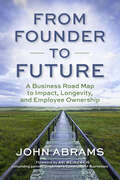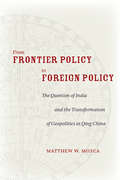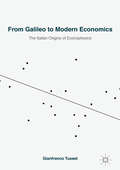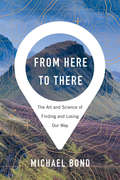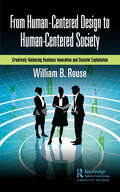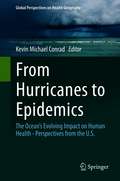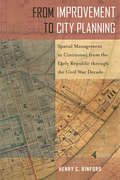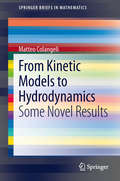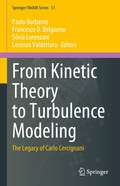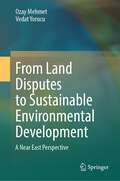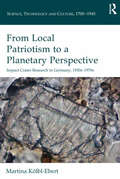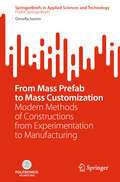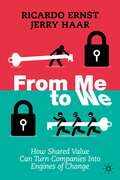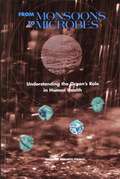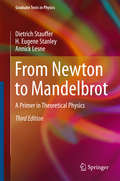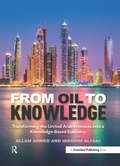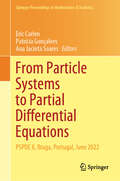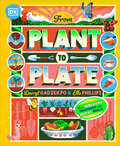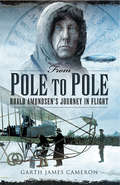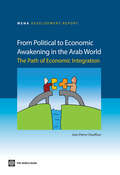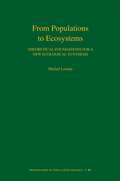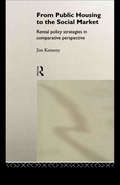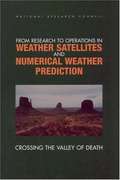- Table View
- List View
From Founder to Future: A Business Roadmap to Impact, Longevity, and Employee Ownership
by John AbramsLearn how to transition leadership, implement shared ownership, and preserve your organization's core values-setting the stage for your business to thrive for generations to come.This visionary but practical handbook offers mission-driven business owners a roadmap for ensuring their company's lasting impact, building leadership internally, and fostering participatory management.Through inspiring real-world stories of B-Corps, worker co-ops, ESOPs, and employee ownership trusts, this book demonstrates how to create resilient organizations that benefit workers and communities.Drawing on his 50-year journey with South Mountain Company and extensive research, Abrams outlines five critical transitions for mission-driven businesses to become what he calls a CommonWealth company:• From founder to next-generation leadership• From sole ownership to widely shared• From hierarchical control to democratic management• From unprotected mission to preserved purpose• From business-as-usual to B Corp force for goodFrom Founder to Future is an essential guide for mission-driven leaders seeking to reshape their businesses for inclusivity, longevity, and positive impact. Whether you're a retiring owner planning your exit, a young entrepreneur building for the future, or an employee working in a purpose-driven business, this book offers a blueprint for creating enduring, values-driven enterprises in the emerging regenerative economy. As 3,000,000 U.S. small business founders over 55 prepare to retire, $10 trillion in assets will change hands over the next two decades. This timely guide shows how to preserve your company's mission and legacy while empowering the next generation.
From Frontier Policy to Foreign Policy: The Question of India and the Transformation of Geopolitics in Qing China
by Matthew W. MoscaBetween the mid-eighteenth and mid-nineteenth centuries, Qing rulers, officials, and scholars fused diverse, fragmented perceptions of foreign territory into one integrated worldview. In the same period, a single "foreign" policy emerged as an alternative to the many localized "frontier" policies hitherto pursued on the coast, in Xinjiang, and in Tibet. By unraveling Chinese, Manchu, and British sources to reveal the information networks used by the Qing empire to gather intelligence about its emerging rival, British India, this book explores China's altered understanding of its place in a global context. Far from being hobbled by a Sinocentric worldview, Qing China's officials and scholars paid close attention to foreign affairs. To meet the growing British threat, they adapted institutional practices and geopolitical assumptions to coordinate a response across their maritime and inland borderlands. In time, the new and more active response to Western imperialism built on this foundation reshaped not only China's diplomacy but also the internal relationship between Beijing and its frontiers.
From Galileo to Modern Economics: The Italian Origins of Econophysics
by Gianfranco TussetEmpirical laws are rare in economics. This book describes efforts to anchor economic knowledge to invariant empirical laws. It links 17th and 18th century Galilean monetary economists to econophysics, a field that emerged in the mid-1990s. This virtual journey from past to present is charted by episodes on aggregates and empirical primacy. It includes the virtually unknown story of 19th century scholars who, by searching for a stricter mathematical approach, paved the way to an ‘engineering’ view of economics. Then there are celebrities like Pareto and his first empirical law governing the distribution of wealth. Pareto and Amoroso sparked a debate on the skewed distribution that spanned decades, ranging from finance to market transformations, to econophysics, with its concepts and tools inherited from statistical physics. The last stage of the journey goes through econophysics and the recent gradual advances it has made, which show how its position vis-à-vis economics has been changing.
From Here to There: The Art and Science of Finding and Losing Our Way
by Michael BondA wise and insightful exploration of human navigation, what it means to be lost, and how we find our way. How is it that we can walk unfamiliar streets while maintaining a sense of direction? Come up with shortcuts on the fly, in places we’ve never traveled? The answer is the complex mental map in our brains. This feature of our cognition is easily taken for granted, but it’s also critical to our species’ evolutionary success. In From Here to There Michael Bond tells stories of the lost and found—Polynesian sailors, orienteering champions, early aviators—and surveys the science of human navigation. Navigation skills are deeply embedded in our biology. The ability to find our way over large distances in prehistoric times gave Homo sapiens an advantage, allowing us to explore the farthest regions of the planet. Wayfinding also shaped vital cognitive functions outside the realm of navigation, including abstract thinking, imagination, and memory. Bond brings a reporter’s curiosity and nose for narrative to the latest research from psychologists, neuroscientists, animal behaviorists, and anthropologists. He also turns to the people who design and expertly maneuver the world we navigate: search-and-rescue volunteers, cartographers, ordnance mappers, urban planners, and more. The result is a global expedition that furthers our understanding of human orienting in the natural and built environments. A beguiling mix of storytelling and science, From Here to There covers the full spectrum of human navigation and spatial understanding. In an age of GPS and Google Maps, Bond urges us to exercise our evolved navigation skills and reap the surprising cognitive rewards.
From Human-Centered Design to Human-Centered Society: Creatively Balancing Business Innovation and Societal Exploitation
by William B. RouseA human-centered society creatively balances investments in sources of innovation, while also governing in a manner that eventually limits exploitation by originators once innovations have proven their value in the marketplace, broadly defined to include both private and public constituencies. The desired balance requires society to invest in constituencies to be able to create innovations that provide current and future collective benefits, while also assuring society provides laws, courts, police, and military to protect individual rights to life, liberty, and the pursuit of happiness. The balance addresses collectivism vs. individualism. Collectivism emphasizes the importance of the community. Individualism, in contrast, is focused on the rights and concerns of each person. Unity and selflessness or altruism are valued traits in collectivist cultures; independence and personal identity are central in individualistic cultures. Collectivists can become so focused on collective benefits that they ignore sources and opportunities for innovation. Individualists can tend to invest themselves, almost irrationally, in ideas and visions, many of which will fail, but some will transform society. Collectivists need to let individualists exploit their successful ideas. Individualists need to eventually accept the need to provide collective benefits. This book addresses the inherent tension underlying the pursuit of this balance. It has played a central role in society at least since the Industrial Revolution (1760–1840). Thus, the story of this tension, how it regularly emerges, and how it is repeatedly resolved, for better or worse, is almost a couple of centuries old. Creating a human-centered society can be enabled by creatively enabling this balance. Explicitly recognizing the need for this balance is a key success factor. This book draws upon extensive experiences within the domains of transportation and defense, computing and communications, the Internet and social media, health and wellness, and energy and climate. Balancing innovation and exploitation takes varying forms in these different domains. Nevertheless, the underlying patterns and practices are sufficiently similar to enable important generalizations.
From Hurricanes to Epidemics: The Ocean's Evolving Impact on Human Health - Perspectives from the U.S. (Global Perspectives on Health Geography)
by Kevin ConradThis book provides a complete and current overview of the correlation between ocean conditions and human health, publishing comprehensively for the first time on the direct interactions among oceanography, marine biology and impacts on human health. Specifically the text addresses how changing ocean conditions result in health impacts and disruptions, with a focus on cases in the USA. The changing ocean conditions that are discussed include diminishing marine biodiversity, climactic changes such as intensified weather events, shifting sea currents and increasing sea temperature. The book addresses the resulting health issues brought about by these various ocean conditions, such as emerging infectious diseases, starvation and poisoning among impacted communities, toxic algae blooms, threatened ecosystems, and other future implications. The text was developed in conjunction with scientists from Brown University, the University of Rhode Island, the University of Texas at Austin, the University of California at Riverside and Ochsner Health, all located in areas deeply impacted by the changing Oceans. The book will be of interest to marine research scientists, health care professionals, students, and general enthusiasts of oceanography and health.
From Improvement to City Planning: Spatial Management in Cincinnati from the Early Republic through the Civil War Decade (Urban Life, Landscape and Policy)
by Henry C. BinfordFrom Improvement to City Planning emphasizes the ways people in nineteenth-century America managed urban growth. Historian Henry Binford shows how efforts to improve space were entwined with the evolution of urban governance (i.e., regulation)—and also influenced by a small group of advantaged families. Binford looks specifically at Cincinnati, Ohio, then the largest and most important interior city west of the Appalachian Mountains. He shows that it was not just industrialization, but also beliefs about morality, race, health, poverty, and “slum” environments, that demanded an improvement of urban space. As such, movements for public parks and large-scale sanitary engineering in the 1840s and ’50s initiated the beginning of modern city planning. However, there were limitations and consequences to these efforts.. Many Americans believed that remaking city environments could also remake citizens. From Improvement to City Planning examines how the experiences of city living in the early republic prompted city dwellers to think about and shape urban space.
From Kinetic Models to Hydrodynamics
by Matteo ColangeliFrom Kinetic Models to Hydrodynamics serves as an introduction to the asymptotic methods necessary to obtain hydrodynamic equations from a fundamental description using kinetic theory models and the Boltzmann equation. The work is a survey of an active research area, which aims to bridge time and length scales from the particle-like description inherent in Boltzmann equation theory to a fully established "continuum" approach typical of macroscopic laws of physics.The author sheds light on a new method--using invariant manifolds--which addresses a functional equation for the nonequilibrium single-particle distribution function. This method allows one to find exact and thermodynamically consistent expressions for: hydrodynamic modes; transport coefficient expressions for hydrodynamic modes; and transport coefficients of a fluid beyond the traditional hydrodynamic limit. The invariant manifold method paves the way to establish a needed bridge between Boltzmann equation theory and a particle-based theory of hydrodynamics. Finally, the author explores the ambitious and longstanding task of obtaining hydrodynamic constitutive equations from their kinetic counterparts. The work is intended for specialists in kinetic theory--or more generally statistical mechanics--and will provide a bridge between a physical and mathematical approach to solve real-world problems.
From Kinetic Theory to Turbulence Modeling: The Legacy of Carlo Cercignani (Springer INdAM Series #51)
by Paolo Barbante Francesco D. Belgiorno Silvia Lorenzani Lorenzo ValdettaroThe book collects relevant contributions presented at a conference, organized in honour of Carlo Cercignani, that took place at Politecnico di Milano on May 24–28, 2021. Different research areas characterizing the scientific work of Carlo Cercignani have been considered with a particular focus on: mathematical and numerical methods for kinetic equations; kinetic modelling of gas mixtures and polyatomic gases; applications of the Boltzmann equation to electron transport, social phenomena and epidemic spread; turbulence modelling; the Einstein Classical Program; Dynamical Systems Theory.
From Land Disputes to Sustainable Environmental Development: A Near East Perspective
by Ozay Mehmet Vedat YorucuThis book is written to transform land disputes toward win-win outcomes utilizing the latest sustainable development theory. Land has always been a source of conflict, a contest of competing homelands and ideologies, but it can also act as an agency of peace-making, promoting economic and social development. This dualism will be the theme of this book as there is a dearth of studies exclusively focused on land. The book's coverage is comprehensive, examining land and property disputes with case studies in modern times along with a problem-solving approach utilizing such economic theorems as Location and Growth Poles theories. The UN’s Sustainable Development Goals will be used as our over-arching framework. The overall aim of the book is to transform land disputes toward win-win outcomes utilizing latest sustainable development theory.
From Local Patriotism to a Planetary Perspective: Impact Crater Research in Germany, 1930s-1970s (Science, Technology and Culture, 1700-1945)
by Martina Kolbl-EbertThe Nördlinger Ries and Steinheim Basin, two conspicuous geological structures in southern Germany, were traditionally viewed as somewhat enigmatic but nevertheless definitely volcanic edifices until they were finally recognized as impact craters in the 1960s. The changing views about the origin of the craters mark an important paradigm shift in the Earth sciences, from an Earth-centric approach to a planetary perspective that acknowledged Earth’s place in the wider cosmos. Drawing on a range of printed sources, detailed archival material, letters, personal notes, and interviews with veterans of Ries research, Martina Kölbl-Ebert provides a detailed reconstruction, not only of the historical sequence of events throughout the twentieth century, but also of the personal thoughts, emotions and motives of the scientists involved and the social context of their research. She shows that there was a sudden reconnection of German researchers with the international scientific community, particularly with more progressive American researchers, after some twenty-five years of scientific isolation during the build-up to WWII and its aftermath. This reconnection brought about not only a new view of geoscience, but also saved German geology from self-sufficiency and patriotic arrogance by integrating it in an interdisciplinary and international framework. In so doing this book sheds much valuable light on an under-explored but crucial development in the way we understand Earth’s history, as well as the way that science functioned during times of conflict.
From Mass Prefab to Mass Customization: Modern Methods of Constructions from Experimentation to Manufacturing (SpringerBriefs in Applied Sciences and Technology)
by Ornella IuorioThis book provides an overview of the latest innovations in prefabrication. It analyzes how digital, material, and process innovations are transforming the mass prefabrication of homes, schools, and offices into mass customization. It provides an understanding of available manufacturing processes, including distributed ownership of manufacturing, platform approaches, and robotics. It discusses how the integration of cutting-edge advanced construction techniques, coupled with robotic manufacturing and assembly from the earliest stages of building system design, has the potential to unlock new formal and technical paradigms. Investigating the impact of prefab in the context of climate emergency, the book analyzes the capacity and shortfall in delivering net zero emissions. It discusses the opportunities that Modern Methods of Construction provide to enable the transition towards circular constructions, from reuse to retrofitting. Including the users' experience, it demonstrates the importance of developing methodologies for capturing users' occupancy evaluation, as a means for understanding real performances, benchmarking indicators, and tuning systems to target the long-term well-being of the occupants. Referring to a plethora of emblematic cases, this work demonstrates the importance of investing in research and development to optimize construction systems, reduce material use, facilitate lean construction, advance mechanical and environmental performances, and move toward circular systems to close the loop. This book is aimed at practitioners, architects, technologists, researchers, and students in architectural engineering.
From Me to We: How Shared Value Can Turn Companies Into Engines of Change
by Jerry Haar Ricardo ErnstShared value is a management strategy in which companies find business opportunities in social problems. While philanthropy and CSR focus efforts focus on “giving back” or minimizing the harm business has on society, shared value focuses company leaders on maximizing the competitive value of solving social problems in new customers and markets, cost savings, talent retention, and more.This book takes the concept of shared value to the next level, with the concept of “Me to We” (also abbreviated as “M2W”) and discusses the current state of the business-environment-government relationship and shows how the shared value model can contribute to each entity. Citing real cases and examples from multiple industries, the authors show that shared value promotes shareholder interests while serving as a successful business strategy. Chapters explore the emerging phenomenon of shared value, the shareholder-stakeholder comparisons, the role of government in the stakeholder environment, shared value as it related to competitiveness, and operational issues such as implementation, communication, and leadership in their relationship to shared value.Readers will find useful strategies of Me to We and its implementation by firms that have become leaders in their market. They will receive ideas and insights into business strategies that will overshadow CSR activities as a differentiation or brand development strategy of the past.Featuring interviews with corporate executives offering their perspectives on shared value, this book will discuss shared value within the context of business and society, competitiveness, and globalization.
From Me to We: The Five Transformational Commitments Required to Rescue the Planet, Your Organization, and Your Life
by Bob DoppeltIn From Me to We: The Five Transformational Commitments Required to Rescue the Planet, Your Organization, and Your Life, systems change expert Bob Doppelt reveals that most people today live a dream world, controlled by false perceptions and beliefs. The most deeply held illusion is that all organisms on Earth, including each of us, exist as independent entities. At the most fundamental level, the change needed to overcome our misperceptions is a shift from focusing only on "me" – our personal needs and wants – to also prioritizing the broader "we": the many ecological and social relationships each of us are part of, those that make life possible and worthwhile. Research shows that by using the techniques described in this book this shift is possible – and not that difficult to achieve. From Me to We offers five transformational "commitments" that can help you change your perspective and engage in activities that will help resolve today's environmental and social problems. Not coincidentally, making these commitments can improve the quality of your life as well. Bob Doppelt's latest book is a wake-up call to the creed of individualism. He calls for recognition of the laws of interdependence, cause and effect, moral justice, trusteeship, and free will. The book will be essential to all of those interested in how we can create and stimulate a sea change in how to enable the necessary behavioral change we need to deal with the myriad environmental and social pressures consuming the planet.
From Monsoons to Microbes: Understanding the Ocean's Role in Human Health
by National Research CouncilWhat can sharks teach us about our immune system? What can horseshoe crabs show us about eyesight?The more we learn about the ocean, the more we realize how critical these vast bodies of water are to our health and well-being. Sometimes the ocean helps us, as when a marine organism yields a new medical treatment. At other times, the ocean poses the threat of coastal storm surges or toxic algal blooms.From Monsoons to Microbes offers a deeper look into the oceans that surround us, often nuturing yet sometimes harming humankind. This book explores the links among physical oceanography, public health, epidemiology, marine biology, and medicine in understanding what the ocean has to offer. It will help readers grasp such important points as: How the ocean's sweeping physical processes create long-term phenomena such as El Nino and short-term disastrous events such as tsunamis--including what communities can do to prepare.What medicines and nutritional products have come from the ocean and what the prospects are for more such discoveries.How estuaries work--where salt and fresh water meet--and what can go wrong, as in the 7,000 square mile "dead zone" at the out-flow of the Mississippi River.How the growing demand for seafood and the expansion of ocean-going transport has increased our exposure to infectious agents--and how these agents can be tracked down and fought.Why "red tides" of toxic algae suddenly appear in previously unaffected coastal areas, and what happens when algal toxins find their way into our food supply or the air we breathe. The book recommends ways we can implement exciting new technologies to monitor the physics, chemistry, and biology of the ocean to recognize change as it happens. From the impact of worldwide atmospheric warming to the significance of exotic bacteria from submarine hydrothermal vents, the ocean has many depths left to explore.
From Newton to Mandelbrot
by H. Eugene Stanley Dietrich Stauffer Annick LesneThis textbook takes the reader on a tour of the most important landmarks of theoretical physics: classical, quantum, and statistical mechanics, relativity, electrodynamics, as well as the most modern and exciting of all: elementary particles and the physics of fractals. The second edition has been supplemented with a new chapter devoted to concise though complete presentation of dynamical systems, bifurcations and chaos theory. The treatment is confined to the essentials of each area, presenting all the central concepts and equations at an accessible level. Chapters 1 to 4 contain the standard material of courses in theoretical physics and are supposed to accompany lectures at the university; thus they are rather condensed. They are supposed to fill one year of teaching. Chapters 5 and 6, in contrast, are written less condensed since this material may not be part of standard lectures and thus could be studied without the help of a university teacher. An appendix on elementary particles lies somewhere in between: It could be a summary of a much more detailed course, or studied without such a course. Illustrations and numerous problems round off this unusual textbook. It will ideally accompany the students all along their course in theoretical physics and prove indispensable in preparing and revising the exams. It is also suited as a reference for teachers or scientists from other disciplines who are interested in the topic.
From Oil to Knowledge: Transforming the United Arab Emirates into a Knowledge-Based Economy
by Allam Ahmed Ibrahim AlfakiOver-reliance on oil challenges the long-term sustainability of an economy. The UAE’s government has placed considerable focus on a comprehensive strategic planning exercise to transform the country’s economic structure from relying heavily on hydrocarbon resources to becoming a knowledge-based economy. Non-oil is to account for 80% of the country’s economy by 2021. From Oil to Knowledge examines the role of this major powerhouse of the Arab World to transform itself into a leader in the adoption of science, technology and innovation to drive economic success on the international stage.In this first book to present and critically evaluate the extent of the UAE’s success in diversifying its economy and implementing the principles and approaches of a Knowledge Economy, the authors identify the achievements of the government to date and the areas of further development. From Oil to Knowledge will be utilized as a guide by policymakers and senior managers to enhance their ability to think strategically towards implementing the pillars of a Knowledge Economy within their own organisations and nation states.
From Particle Systems to Partial Differential Equations: PSPDE X, Braga, Portugal, June 2022 (Springer Proceedings in Mathematics & Statistics #465)
by Patrícia Gonçalves Ana Jacinta Soares Eric CarlenThis book presents the proceedings of the international conference Particle Systems and Partial Differential Equations X, which was held at the University of Minho, Braga, Portugal, from 2022. It includes papers on mathematical problems motivated by various applications in physics, engineering, economics, chemistry, and biology.
From Plant to Plate: Turn Home-Grown Ingredients Into Healthy Meals!
by Ella Phillips Darryl GadzekpoGrow mighty ingredients, then take them from mud kitchen to real kitchen and transform them into delicious, plant-powered feasts.Grab your shovel and plant for a recipe! Discover 15 incredible plants, including zucchini, raspberries, corn, and basil, then find out what it takes to make them grow. From showing you how seeds should be properly planted to helping you find the best soil for your plants, Darryl Gadzekpo and Ella Phillips offer all the tips and tricks green-fingered kids need to know to transform seeds into mighty fruit, vegetables, and herbs your tummies would be proud of.But the fun doesn't end here! Once you've removed those muddy boots, head to the kitchen and learn how to prepare and cook your home-grown ingredients. With more than 25 tasty recipe ideas from basil pesto pasta to butternut squash muffins, you'll master a variety of unique plant-powered food that you'll love to eat as much as you love to cook.A visual feast for 7–9-year-olds, From Plant to Plate is the perfect book to inspire kids to get growing, get cooking, and get plant-powered eating.
From Pole to Pole: Roald Amundsen's Journey in Flight
by Garth James CameronRoald Amundsen (1872-1928) was the most successful polar explorer of his era using sledges, dogs, ski and ships. He is mainly remembered for being the first man to reach the South Pole on 14 December 1911. What is less often remembered is that he was also the first man to reach the North Pole on 12 May 1926 as the leader of the Amundsen- Ellsworth-Nobile expedition in the airship Norge. His involvement in aviation from 1909 to his death in 1928, has not been the subject of a detailed study until now.This book explores Amundsen's enthusiasm for flight from the moment he read about Bleriot's flight across the English Channel in an aeroplane on 25 July 1909. From that moment onwards he saw the potential of aircraft as vehicles to explore portions of the globe that remained unexplored in the first quarter of the 20th century. The man-lifting kites built by Einar Sem-Jacobsen took the life of his second in command, Ole Engelstad and were carried, but not used, during his 1910-1912 expedition to the South Pole. He saw aeroplanes flying in America and Germany in 1913 and in 1914 he was taught to fly by Sem-Jacobsen. He passed his flight test on a Farman Longhorn biplane on 1 June 1914 and in mid-1915 was issued with the Fédération Aéronautique Internationale (Norge) aeroplane pilot's certificate number one. He bought a Farman biplane to take with him on an expedition to the North Polar Sea but the outbreak of the Great War stopped the Expedition and Amundsen gave his Farman to the Norwegian government. After the war he acquired a Curtiss Oriole biplane and two Junkers F13's then in 1925 he embarked on a flight, which he barely survived, to the North Pole in two Dornier Wal flying boats. 1926 brought long delayed success when the Norge flew to the Pole and on to Alaska. On 18 June 1928 he and five companions took off from Tromso on a search and rescue flight for the missing airship Italia and were never seen again.
From Political to Economic Awakening in the Arab World
by Francisco H. G. Ferreira Julian Messina Jamele Rigolini Luis-Felipe López-Calva Maria Ana Lugo Renos VakisThe popular grievances that have fueled the Arab Spring since 2010 demonstrate that past development paradigms have failed to achieve the inclusive and sustainable growth expected by Arab populations. Countries in the Middle East and North Africa (MENA) region have failed to develop a strong private sector that is linked with global markets, survives without state assistance, and generates productive employment for young people. One key symptom of this maldevelopment is that, with the exception of the petroleum sector, MENA remains the least trade-integrated region in the world. The Deauville Partnership, launched by the Group of Eight (G8) in Deauville, France, in May 2011, is thus strategic and timely. At the request of the G8, this report provides an analytical framework for increasing trade and foreign direct investment (FDI) for Egypt, Jordan, Libya, Morocco, and Tunisia (the Partnership countries). Increased trade and FDI is a key means by which Partnership countries can achieve a path of sustainable growth that reduces youth unemployment. Moreover, trade and investment can also show short-term results. The G8 countries, Turkey, the Gulf states, and other Deauville partners can help the new Arab democracies achieve their objectives in two main ways: by effectively expanding market opportunities and by supporting domestic regulatory reforms. To start implementing a long-term vision of increased trade and investment integration, based on an integrated economic space in the Mediterranean basin, the Deauville Partnership could focus on five priority areas. These are helping Partnership countries adapt to a fast-changing trade, FDI, and jobs landscape; improving market access opportunities and market regulations; fostering competitiveness, diversification, and employment; facilitating trade and mobilizing trade finance and diaspora resources; and promoting inclusiveness, equity, and sustainability of the structural transformation brought about by the process of integration. The success of the Arab political awakening will greatly depend on the emergence of such an economic awakening that can generate quality employment for the millions of young Arab men and women who seek jobs and a decent life.
From Populations to Ecosystems: Theoretical Foundations for a New Ecological Synthesis (MPB-46) (Monographs in Population Biology #46)
by Michel LoreauThe major subdisciplines of ecology--population ecology, community ecology, ecosystem ecology, and evolutionary ecology--have diverged increasingly in recent decades. What is critically needed today is an integrated, real-world approach to ecology that reflects the interdependency of biodiversity and ecosystem functioning. From Populations to Ecosystems proposes an innovative theoretical synthesis that will enable us to advance our fundamental understanding of ecological systems and help us to respond to today's emerging global ecological crisis. Michel Loreau begins by explaining how the principles of population dynamics and ecosystem functioning can be merged. He then addresses key issues in the study of biodiversity and ecosystems, such as functional complementarity, food webs, stability and complexity, material cycling, and metacommunities. Loreau describes the most recent theoretical advances that link the properties of individual populations to the aggregate properties of communities, and the properties of functional groups or trophic levels to the functioning of whole ecosystems, placing special emphasis on the relationship between biodiversity and ecosystem functioning. Finally, he turns his attention to the controversial issue of the evolution of entire ecosystems and their properties, laying the theoretical foundations for a genuine evolutionary ecosystem ecology. From Populations to Ecosystems points the way to a much-needed synthesis in ecology, one that offers a fuller understanding of ecosystem processes in the natural world.
From Public Housing Soc Market
by J KemenyJim Kemeny develops a conceptual framework to present a critical study of comparative rental markets. The framework centres around the concept of the process of maturation of cost rental housing and two policies for handling this which have been adopted by industrial societies. These are, firstly, the Anglo-Saxon "dualist" system, seen in Great Britain, Australia and New Zealand, and secondly, the Germanic "unitary market" system, seen in Sweden, The Netherlands, Germany and Switzerland. Using a comparative approach based around international case studies, Jim Kemeny shows how each system stems from different power structures, is governed by different policy strategies, and is informed by different ideological views of how markets operate. Offering a radical critique of the orthodox view, it is argued that the time is now right for English-speaking nations to abandon state control over cost renting but allow to it to compete directly with profit renting, as in the "unitary market" model. International in scope, this volume should be of interest to researchers in housing, sociology and related fields.
From Research To Operations In Weather Satellites And Numerical Weather Prediction: Crossing The Valley Of Death
by Board on Atmospheric Sciences ClimateThis workshop report examines the capability of the forecast system to efficiently transfer weather and climate research findings into improved operational forecast capabilities. It looks in particular at the Environmental Modeling Center of the National Weather Service and environmental observational satellite programs. Using these examples, the report identifies several shortcomings in the capability to transition from research to operations. Successful transitions from R&D to operational implementation requires (1) understanding of the importance (and risks) of the transition, (2) development and maintenance of appropriate transition plans, (3) adequate resource provision, and (4) continuous feedback (in both directions) between the R&D and operational activities.
From Resource Scarcity to Ecological Security: Exploring New Limits to Growth
by Dennis Pirages Ken CousinsA new recognition of profound interconnections between social and natural systems is challenging conventional constructs and the policy predispositions informed by them. Our current intellectual challenge is to develop the analytical and theoretical underpinnings of an understanding of the relationship between the social and the natural systems. Our policy challenge is to identify and implement effective decision-making approaches to managing the global environment.
